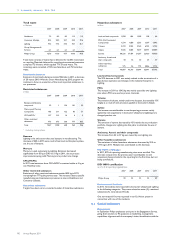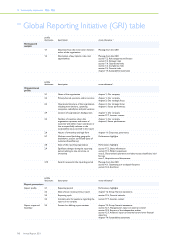Philips 2011 Annual Report Download - page 196
Download and view the complete annual report
Please find page 196 of the 2011 Philips annual report below. You can navigate through the pages in the report by either clicking on the pages listed below, or by using the keyword search tool below to find specific information within the annual report.
14 Sustainability statements 14.6 - 14.6
196 Annual Report 2011
Supplier training and capability building
During 2011 we continued our training programs to support suppliers
in risk countries. We organized classroom training sessions in China,
Brazil and India for suppliers included in the audit program. Over 400
supplier representatives attended the training sessions. In November
we hosted the EICC Worker Management Communication Training in
Shenzhen, China. This was developed in a joint effort by the EICC and
the Fair Labor Association.
Sustainable Trade Initiative IDH
Philips is one of the initiators of the IDH Electronics Program, an
innovative multi-stakeholder initiative sponsored by the Sustainable
Trade Initiative (IDH) together with Dell, HP, Philips and civil society
organizations. The program will work with over 100 electronics
suppliers in China to support innovative workforce management
practices, sustainability and better business performance. The goal is to
improve the working conditions of more than 500,000 employees in
the electronics sector.
The program formally kicked off in October in Shenzhen, China,
bringing together more than 200 participants from 60 suppliers, the
regional government, the Dutch government and a large number of
NGOs and labor unions. The kickoff event galvanized commitment to
the program on the part of all stakeholders, including our suppliers and
the regional government.
The first phase of the program started in November 2011, with four
Philips suppliers joining the program. Suppliers received a so-called
Entry Point Assessment to identify challenges common to factory
management and workers such as worker-management
communication, occupational health and safety, production,
performance management and environmental issues. Each supplier
receives support over a period of up to 24 months on the basis of
improved dialogue between management and workers. The costs of
the program are shared between the supplier, Philips and the IDH.
‘Conflict’ minerals
Conflict minerals can come from many sources around the world
including mines in the Democratic Republic of the Congo (DRC). Philips
is concerned about the situation in the east of the DRC where proceeds
from the extractives sector are used to finance rebel conflicts in the
region. These minerals may end up in products such as cars, planes,
chemicals, packaging and electronics equipment. Philips is committed
to address this issue, even though it does not directly source minerals
from the DRC. Mines are typically seven or more tiers removed in the
supply chain from our direct suppliers. Philips is working towards the
following goals:
• Minimize trade in conflict minerals that benefit armed groups in the
DRC or an adjoining country
• Enable legitimate minerals from the region to enter global supply
chains, thereby supporting the Congolese economy and the local
communities that depend on these exports.
What are conflict minerals?
Conflict minerals are defined in the US Dodd-Frank Act as tin,
tantalum, tungsten and gold. They can come from many sources around
the world, including mines in the DRC which are estimated to provide
approximately 18% of global tantalum production, 4% of tin, 3% of
tungsten and 2% of gold. Some of the mines in the DRC are controlled
by militias responsible for atrocities that have been committed in the
Congolese civil war.
Collaboration with different stakeholders
Philips is actively contributing to the Extractives Work Group, a joint
effort of the EICC and GeSI to positively influence the social and
environmental conditions in the metals extractives supply chain. In 2011
Philips helped organizing the first European session of the EICC-GeSI
Conflict Minerals Workshop in Brussels, which convened over 150
stakeholders from different industries, governments and civil society
organizations. See also http://www.eicc.info/extractives.htm.
Philips engaged with the Dutch government and the European
Parliament to see how we can resolve the issue. We also joined the
multi-stakeholder OECD-hosted pilot to test the OECD Due Diligence
Guidance for Responsible Supply Chains of Minerals from Conflict-
Affected and High-Risk Areas. Furthermore, we continued our
engagement on this topic with relevant Congolese organizations as well
as NGOs in Europe and the US.
Due diligence of the Philips supply chain
We worked with 100 priority suppliers to raise awareness and start
supply chain investigations. Using the EICC-GeSI Due Diligence survey
tool we requested our suppliers to report back their progress and to
disclose which smelters are used in their supply chains. For all four
metals together we identified over 100 smelters in our supply chain.
Conflict-free smelter program
The smelter is at a key point in the supply chain to enforce responsible
sourcing because at that stage minerals from many sources are
processed to produce a refined metal. The EICC-GeSI Conflict-Free
Smelter (CFS) program makes it possible to identify smelters that can
demonstrate through an independent third party assessment that the
minerals they procure did not originate from sources that contribute
to conflict in the DRC.
Having identified more than 100 smelters in our supply chain as a result
of the due diligence, Philips started to invite these smelters to
participate in the CFS program. We also visited a number of smelters
to encourage them to enter the CFS audit program. See
www.conflictfreesmelter.org for more details.
For more details, see www.philips.com/suppliers and the published
Philips position paper on Conflict Minerals.
























